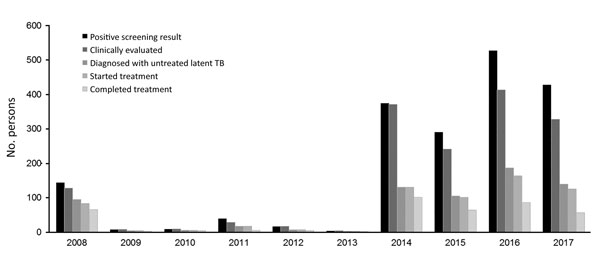Volume 25, Number 3—March 2019
Dispatch
Response to Isoniazid-Resistant Tuberculosis in Homeless Shelters, Georgia, USA, 2015–2017
Figure 2

Figure 2. Cascade of care for persons experiencing homelessness who were tested for latent tuberculosis (TB) infection, Fulton County, Georgia, USA, 2008–2017. Positive screening result indicates number with either a new or prior positive test result at screening; clinically evaluated indicates number evaluated by a clinician; diagnosis of untreated latent TB indicates number with a diagnosis of latent TB who required treatment; started treatment indicates number who started treatment for latent TB; and completed treatment indicates number who completed treatment.
Page created: February 19, 2019
Page updated: February 19, 2019
Page reviewed: February 19, 2019
The conclusions, findings, and opinions expressed by authors contributing to this journal do not necessarily reflect the official position of the U.S. Department of Health and Human Services, the Public Health Service, the Centers for Disease Control and Prevention, or the authors' affiliated institutions. Use of trade names is for identification only and does not imply endorsement by any of the groups named above.